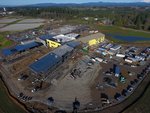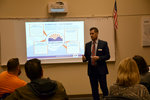

Ridgefield School District is starting preparations on another capital facilities bond, raising the question of why so soon following the approval of a similar measure earlier this year.
The answer? “The need is there,” according to RSD Superintendent Nathan McCann. He was at Ridgefield High School Dec. 13 along with about 20 others for the first meeting of the Capital Facilities Advisory Committee (CFAC), the group that will steer the direction of a plan that could come up to voters’ approval February 2019.
Made up of district employees and parents, this CFAC will continue the works undertaken by the preceding committee that steered the development of this year’s successful bond. The $78 million bond that passed this February with 69 percent in favor has real effects on the ground already, as work on an intermediate-grades campus nearby Ridgefield High School is moving along swiftly.
Prior to the bond passing McCann said the new facilities would result in 1,300 more seats, raising the district’s overall capacity to 3,460 or about 60 percent. That said, at the first CFAC meeting he commented that the Hillhurst Road intermediate campus — which will host two distinct 5-6 and 7-8 grade schools that share some facility resources — would be opening at near capacity when the first students fill the halls next fall.
McCann highlighted the reality of the growth, noting that developments on the Kennedy farm property to the south of the new school complex and those possible in the Gee Creek Plateau area would be bringing in hundreds of homes. Outside of the city proper, growth in the Salmon Creek area within RSD boundaries is also going rapidly.
McCann did have reasoning that such a swift return to a bond ballot measure could work. He said with citizens seeing the rapid construction of the intermediate complex along with the development deluge this year, people are aware that growth is happening — and fast.
“We had such a long winter last year, things got delayed, and so the second things dried out all this heavy equipment emerged on Ridgefield, pouncing like a panther, so to speak,” McCann said.
He said this physical manifestation of the growth was a powerful tool at showing the reality of district growth.
“They can see a spreadsheet with numbers and it doesn’t quite resonate the same way that starting to see subdivision after subdivision start to get underway (does),” McCann said.
McCann did have spreadsheets, however, and the data does show the ramping up of growth.
According to historical student counts found in information presented at the meeting, in 1986 the district had 1,319 students. It took until 2016 to double that number, with that year’s count at 2,731. The data’s projection counts show that the population will likely double again in 2026, with the district projected to surpass 7,000 students by 2035.
Regarding that 3,460 capacity figure, the data shows that in 2019 the district will have likely surpassed even that number.
In order to get higher capacity, this Phase III of an overall four-phase development plan would focus on where the last bond didn’t — kindergarten through fourth grade and ninth through 12th grade. Possibilities listed included a brand-new K-4 building or expansions of the existing Union Ridge and South Ridge elementary schools, and for 9-12 grade students the capacity increase could be either expansions to RHS or a new, smaller school either as a “niche” school or an alternative high school.
McCann highlighted the growth in the upper grades, commenting how although there were 155 graduates of RHS this past year, nearly every subsequent class of students are 200-plus.
Though McCann has sought to demonstrate the need of the district for capital facilities so soon after the last ask, members of the CFAC still didn’t expect to be back at it again so soon for those returning to the fold. One of those returning was Amy Draper, former co-chair of the CFAC during its Phase II iteration.
Draper, a mother of three in the district, said she returned because she was impressed with how involved the community was and how much of a say the community had in helping direct the needs of the bond.
“I like being able to feel like my voice was heard, and the voices of my neighbors and friends,” Draper said, adding that after her efforts for the last bond it made sense to stay the course and see how successful that work will become.
“I feel like if I stopped at the last phase I would miss out on the rest; there’s so much more,” Draper said.
“Even though we’re back so soon I still feel like we’re playing catch-up to how many bodies are moving,” Draper said. “I like that we’re here and ready to get started so that we can be on top of things for the growth.”
Draper acknowledged that the biggest hurdle will be that February 2019 vote. The CFAC, along with Citizens for Ridgefield Schools, an advocacy group for the district, would need to cast a wide net over the district population as they did last time to get the word out.
“That I think is going to be the challenge for this phase, getting the people who just voted … to see the need to vote again,” Draper said.
There is still lots to be decided this early on in the committee process, which McCann said would feature about half a dozen of meetings from January through March (with the possibility of April meetings if work gets behind). Issues such as a debt ceiling that could put a constraint on how much money could be bonded, as well as what exactly the capacity increases would look like are some of what the committee is tasked to do.
Though the proposal of a bond so soon might seem slipshod to some, McCann made a promise to those in the district that their tax dollars would be put to the best use.
“I am 100 percent confident that the district will present a fiscally-responsible, well-shaped, well-articulated bond that meets as many of the needs as capacity will allow for,” McCann asserted.